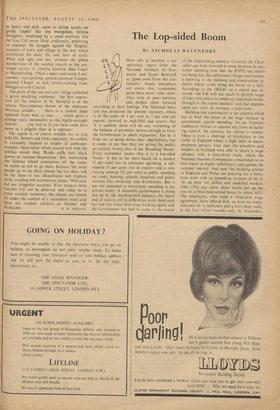Dyfed
Shell Guide to South-West Wales : Pembroke- shire and Carmarthenshire. By Vyvyan Rees. (Faber, 15s.) HERE'S a zestful guide, and full of meat. The author, in spite or because of bearing a name proud in Welsh history (the Lords Rhys), sees the land without sad Celtic twilight of misty mystic shadows. Through the thin clear light of the west he discerns a beautiful and friendly county, and in his gazetteer describes it with a racy yet sensitive touch, alive to the vigorous history of man's activity with stone and brick, especially with those abundant principal monu- ments—cromlech, castle, church and chapel. We are told they are good, bad, indifferent, musty, exciting, worth or not worth visiting. The more than hundred-year-old criticism (in the rage of chapel-building of that time, Victor Hugo, exiled in Jersey in 1852, sneered at his new home in Marine Parade with the words, 'a place like a piece of built Methodism') that Wales has no architecture save its hideous Victorian chapels is here confounded by what is clearly the con- spiracy of those Victoriana boys Betjeman and Piper, editors of the Shell Guides; we are taught here to discover and delight in that ugliness, to be in the fashion and approve clashing colours and uncompromising box-like beauty.
One has to admit that the guide succeeds in this respect, with pages and end-pages filled with black-and-white Piper photographs of chapel fronts, very telling and compelling; and a dramatic frontispiece in colour of Croes-goch (Red Cross) Chapel—Welsh-butter-yellow with dandy russet trimmings and the deep-blue sky above. The ancient Anglican churches, described as hoary and dark, seem to shrink beside the gaudy 'capels' like lost evangelists, forlorn foreigners, weakened by a creed outworn. For ' the true Celt never liked conformity, preferring to continue the struggle against the 'English' invasion of town and village in this way which stimulated his daily life and love of strife. 'Plain and ugly you are,' protests the gilded weathervane of the sombre church to the gro- tesque turrets or 'cinema Gothick Hen Capel' at Maenclochog. 'There's smart and lovely I am,' answers 'eye-catching apricot-coloured Congre- gational Chapel' to dull, inward-looking Llan- filiangel-ar-arth Chorch.
The glory of the one and only village cathedral is given satisfying treatment: 'the first impres- sion [of the interior of St. David's] is of the velvety lilac-coloured bloom of the elaborate Norman arcades . . . there is a violent slope upwards from west to east . . . which gives a strange rustic personality to this highly-wrought interior . . . you feel as if you have come here more as a pilgrim than as a sightseer.'
The region is, of course, 'notable for its rich wild life, flowers and birds especially; the author is excusably inspired to heights of anthropo- morphic observation which accord well with the holiday mood; thus, 'Rooks ruffle their black gowns in raucous disputation.' But, mentioning the famous island sanctuaries off the coast, he warns us not to go there, because 'the more People go to see these islands the less there will be for them to see. Disturbance will frighten birds, treading will exterminate plants.' Well said, but not altogether accurate. Your modern bird- watcher will not be deterred, and today he is better trained; moreover, the islands are almost all under the control of a naturalists' trust, and there are resident wardens on Skorner and































 Previous page
Previous page